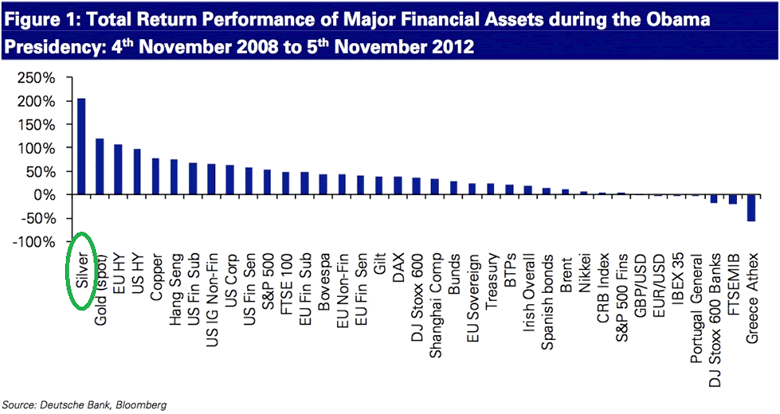Just seeing how gold and silver prices have reacted after QE4 was announced should be enough to convince even the most skeptical investors that the gold and silver markets are not really « free markets » and that the prices are really being manipulated.
(The recent Libor scandal, latest example to date, reveals the unthinkable size of the manipulations the banking sector is able to realize. UBS, along with other guilty banks, will have to pay $1.5 Billion in fines for manipulation.)
Prices have dropped in the days following the QE4 announcement, and there is normally no more positive news for the precious metals than the announcement of massive money printing.
Gold has always served as a barometer for measuring the true « health » of the world financial system. Breaking this barometer helps in hiding the system’s fragility and the real inflation rate and, most importantly, to hinder the normal understanding, or logical tie, between the destruction of the monies’ purchasing power and the rise in the price of gold.
I’m not going to explain this manipulation again, which I have done many times (read here), because, despite its existence, the prices of gold and silver have performed significantly for the last 12 years and are even the two best performing assets during President Obama’s last term.

Let’s just remind ourselves that the fundamentals behind this 12-year progression are still in place (near-zero interest rates, negative real interest rates, loss of confidence in paper money and massive demand from emerging countries) and that investing in gold or silver without being aware of price manipulation makes it hard for the investors to support this artificial volatility, which is generated to slow down a massive movement towards the precious metals.
Let’s rather look at how the precious metals have fared in the months following each new QE announcement, and let’s look at the situation on the physical gold and silver markets.
What indications do the physical gold and silver markets give us ?
Investors must take into account the facts observed on the physical markets, not only the spot price, to understand where the price is headed :
- Central banks keep buying physical gold, despite the volatility of these last months. Irak just tripled its gold reserves in two months by buying 25 extra tons. Korea raised its physical gold reserves by 20% in November. Brazil doubled its gold reserves in August 2012 by buying 15 tons. Russia bought nearly three tons of gold in November.
- The dichotomy between the « paper » and physical markets is growing with massive demand for physical gold and silver coming mostly from Asia. It is costing more and more above the spot price to acquire physical gold and silver. We just learned that, in China, one has to pay $2.89 an ounce above the spot price to acquire physical silver, or a 9.6% premium above spot. Asian brokers know that manipulation is creating an artificially low price and refuse to sell physical silver based on « paper » spot prices.
- Chinese diplomats are confirming that China is accumulating physical gold to insure the yuan’s convertibility into physical gold.
- Japanese hedge funds just started to invest in gold.
- The US Mint has suspended the sale of Silver Eagles for three weeks in order, in my opinion, to prevent having to sell at an artificially depressed price which wouldn’t cover production costs.
Post QE : how gold and silver fare
What quantitative easing, or QE, means is debt monetization. Monetization is realized through the creation of newly printed money. Said money did not exist before, hence the inflationary characteristic of those « plans » that contribute to the swelling of the monetary mass.
These plans entail the government issuing more debt (in the form of Treasury bonds) which is bought by a central bank that creates, out of thin air, the necessary money to buy those bonds.
These monetary easing plans are highly inflationary when central banks are directly buying Treasury bonds from the governments because governments then spend this money that spreads into the economy.
This new money then circulates in the economy and when the monetary mass rises faster than the real economy, inflation sets in.
When central banks purchase debt issued by banks (like the MBS), these banks do not necessarily spend this money; they may keep it and use it to re-capitalize, or to speculate with.
This is an important nuance because it determines the inflationary characteristics of each quantitative easing plan. Precious metals react more or less violently and rapidly depending on the type of easing plan.
If we take a look at silver’s performance since QE1 we see :
As perfectly explained by Adam Hamilton in a recent article, here is how silver performed after each QE announcement :
QE1 : $1,750B have been created to buy Treasury bonds and mortgage-backed securities, out of which « only » $300B were used for U.S. T-bonds. Silver rose 80% after QE1.
QE2 : $900B were created to directly buy Treasury bonds from the US government, the most inflationary type. Silver price progressed by 89% for the period, reaching +177% nine months after the announcement, but went through a correction thereafter.
QE3 : In September, 2012, QE3 started with printing $40B a month. This time, the whole amount was dedicated to buying mortgage-backed securities (MBSs) only, no T-bonds. For a reminder, banks do not spend this money directly in the economy after selling those MBSs.
QE4 : The Fed just announced that, on top of the $40B/month for MBSs, it will be buying $45B/month of US Treasury bonds. But there’s a big difference this time : there is no time limit, so it could last for years, because the only benchmark the Fed has set is to continue with this plan for as long as unemployment sits above 6.5%. The last time unemployment was at that level was in 2008, four years ago. That should give us an idea of how many years this highly inflationary plan could last and of the astronomical quantity of money that will need to be printed.
QE4 will certainly entail more money printing than QE1 and QE2 combined.
QE4 is set to start officially in January 2013.
Conclusion :
The price correction after the announcement of QE4 is temporary and is in no way tied to a negative evolution of the fundamentals that have held these prices for 12 years. On the contrary, the fundamentals have never looked so good for precious metals.
This correction is due more to manipulation techniques aiming to keep investors in the dark about the relation between monetary policies and the performance of gold than to any logical explanation.
After each QE announcement, from 1 to 4, whether for Treasury bonds or MBSs, the prices of gold and silver have corrected without any fundamental reason that could explain it.
The announcement of the most inflationary quantitative easing of all times (buying Treasury bonds) virtually guarantees that, in the months to come, the prices of precious metals will be on the rise.
Reproduction, in whole or in part, is authorized as long as it includes all the text hyperlinks and a link back to the original source.
The information contained in this article is for information purposes only and does not constitute investment advice or a recommendation to buy or sell.


































